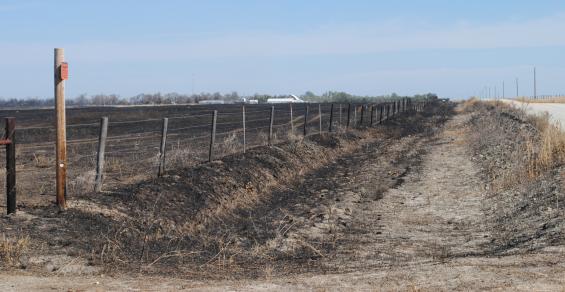Nebraska Extension crops, livestock, food and families teams have put together a series of questions and answers for those hit by wildfires.
While this information may not hit every question producers might face, it is a good starting point. Here are some answers to those questions:
Should I plant now? It is recommended to plant something as soon as possible. Some are planting oats to get a cover to grow quickly and hold the soil in place. The oats can be used for forage, or they can be burned off with herbicide after planting corn or soybeans into them.
What should I plant? If you typically plant corn, sorghum and soybeans and are most comfortable with them, stick with that. If you need forages and are comfortable with planting them, that could be a wise option this year.
For irrigated cornfields in which pivots have been affected and you are unsure if a pivot will be in place this growing season, consider reducing seeding rate to about 18,000 seeds per acre and use a hybrid with greater flex, if available. Each person should talk with their pivot dealer to determine the potential opportunity for pivot replacement before making a final seeding rate decision.
Planting soybeans as soon as possible can aid in yields. There really should be no changes to seeding rates. University of Nebraska research has consistently shown no reduced yields when planting 120,000 seeds per acre in 30-inch rows in silt-loam soil versus planting 180,000 seeds per acre. UNL research has also shown best yields at 1.75-inch depth. Considerations are to plant into moisture.
If there is moisture at 1 inch after recent rains to get soybeans germinated before preplant herbicides are applied, that could be an option too. The concern is when soybeans are planted shallow into dry soil, and rain or irrigation moves PPO-inhibiting herbicide into the seed zone where soybeans are imbibing water containing the herbicide. Get more details at cropwatch.unl.edu.
Sorghum can be seeded by mid- to late May. If one is unsure if a pivot will be available, a nonirrigated seeding rate could be planted for this year, which would be about 55,000 seeds per acre, and double that rate for irrigated sorghum.
Annual forage systems are also an option, particularly for those with livestock where forage resources were lost to the fire. The quickest thing to plant right now would be oats. The oats could be grazed, hayed or greenchopped. Once the oats are completed, putting in a warm-season annual like pearl millet, sorghum sudan or forage sorghums, or a warm-season annual mix in July, can be beneficial.
Pearl millet has the smallest stems for allowing a hay crop and also regrowth for grazing. It won’t provide the biomass of some of the forage sorghums that are harder to hay. The regrowth could be grazed through the winter, or if hayed off, a cool-season mix of a small grain such as cereal rye, wheat, triticale or oats — with the addition of brassicas such as turnips, collards, radishes or rape — could be planted by Sept. 1.
This would provide forage through the winter and early spring. Should it be a dry season, you may wish to consider forage insurance, which can be purchased based on average rainfall for your area. Learn more atfarm.unl.edu.
What happened to the nutrients in my field? If dry fertilizer was spread and lying on the surface of the fields, it was most likely lost because of fire or wind. If dry fertilizer was incorporated, it will depend on how deep the incorporation was and how much topsoil was lost to wind. If fertilizer was injected or knifed in, it most likely is still present. Soil samples either preplant or during growing season will give an indication of how much nitrogen is available to the growing crop.
Nutrients from the residue, whether one year or multiple years from continuous no-till, were most likely lost because of the fire and wind. The nitrogen and sulfur in the residue would have been lost to the atmosphere. The phosphorus and potassium in the residue would remain in the ash, if the ash were still present on the field and not removed by wind.
In general, research has found that the nutrient content within the residue would not need to be replaced for this year, particularly regarding nitrogen, as the C:N ratio has changed and more mineralization can occur. What we don’t know is the impacts on microbes due to the fire. Don’t worry about figuring out nitrogen needs now, but get something planted, if at all possible. Learn more at cropwatch.unl.edu.
Is prevented planting coverage payable on crops that could not be planted due to severe drought conditions? The Risk Management Agency says that prevented planting coverage is provided for drought, failure of irrigation water supply, failure or breakdown of irrigation equipment or facilities, or the inability to prepare the land for irrigation using the policyholder’s established irrigation method, due to an insured cause of loss, as provided by the policy.
Prevented planting will be provided only if, by the final planting date, or within the late-planted period if the insured elected to plant the crop, the policyholder provides verifiable documentation demonstrating the drought conditions that are acceptable to the approved insurance provider. AIPs are to take into consideration if the area that is prevented from being planted has insufficient soil moisture for germination of seed or would make insufficient progress toward crop maturity due to a prolonged period of dry weather to achieve the per-acre guarantee on the acreage.
In regard to the phrase, “insufficient soil moisture for germination of seed or progress toward crop maturity,” there rarely is enough soil moisture at the time a crop is planted to carry the crop to full maturity. Normally, a nonirrigated crop depends on expected seasonal rains throughout the growing season to mature.
“Insufficient soil moisture for progress toward maturity” means the crop may germinate, but there is insufficient moisture to sustain the germinated plants. Learn more at rma.usda.gov.RMA also has a wildfire FAQ page at rma.usda.gov.
Nebraska Extension experts answer common questions about crop and forage planting after a wildfire.





